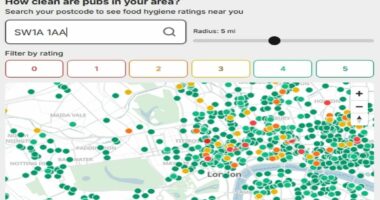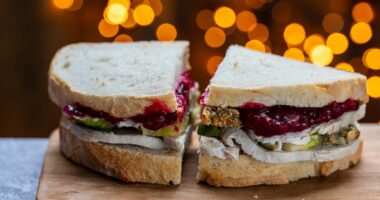Share this @internewscast.com
There’s a new craze taking over TikTok, beauty clinics, celebrity circles and wellness forums, and it has the whiff of a quick-fix culture we should have outgrown by now.
Microdosing GLP-1 drugs, like Ozempic or Wegovy, is being touted as a subtler, safer way to lose weight for perimenopausal or menopausal women.
Smaller doses, fewer side effects, or so the story goes.
But as someone who works in the trenches with women fighting metabolic change, hormonal chaos and the very real frustration of weight gain in midlife, I can’t stay quiet on this.
The messaging is seductive. But the science and ethics are far more complicated.
Because here’s the uncomfortable truth: we’ve started treating powerful medication like a lifestyle accessory. And we’re doing it under the false assumption that weight, and by extension, health, can be hacked with a syringe and a spreadsheet.
Originally designed for type 2 diabetes, GLP-1 receptor agonists like semaglutide mimic a hormone that slows digestion, suppresses appetite and enhances insulin secretion. In full doses, these drugs are clinically proven to cause weight loss, and they’ve become so popular that global shortages have impacted diabetic patients.
But now, a growing number of non-obese, non-diabetic individuals, often guided by aesthetic goals rather than medical need, are experimenting with microdosing.

Some semaglutide users are convinced microdosing prevents the visible gauntness associated with GLP-1 drugs, sometimes known as ‘Ozempic face’ (stock image of Ozempic injection pen)

Nutritionist Faye James warns against microdosing, saying low doses haven’t been subjected to thorough medical testing, nor is there any evidence they result in fewer side effects
Microdosing, in short, refers to taking less than the normal prescribed dose of a medication.
People either do this with the help of a clinician who is willing to try an alternative path to the standard therapeutic route or, more commonly, they go it alone.
The logic is simple: take just enough to blunt hunger, but not so much that you experience side effects like nausea or fatigue.
Some semaglutide microdosers are also convinced this method prevents the visible gauntness associated with the drug, sometimes known as ‘Ozempic face’.
But it’s all rubbish, dieting’s latest illusion. The idea that a ‘Goldilocks dose’ trims the waistline without rocking the system has absolutely zero scientific basis.
There is no robust data showing microdosing GLP-1 drugs is safe, effective or sustainable. The clinical trials – the ones regulators rely on to approve use – are based on full, titrated doses. Anything else is guesswork.
The reality is, when you’re manipulating a hormone as potent as GLP-1, guesswork can be dangerous. Reducing your dose and taking it more frequently might sound harmless, but how do you know for sure?
Supporters of microdosing often cite milder side effects and the ability to ‘listen to their bodies’, as if adding a hormone analogue to your system is some sort of intuitive eating.
But semaglutide and drugs like it don’t just reduce hunger. They slow gastric emptying, alter blood sugar response and, in many cases, cause rapid shifts in body composition, including loss of lean muscle. This happens regardless of dosage.


Sharon Osbourne has one of the most documented examples of the semaglutide side effect called ‘Ozempic face’
For women in perimenopause or menopause, who are already facing declining oestrogen, shifting fat distribution and loss of bone density, this is particularly problematic.
We’re not talking about the odd burp or skipped snack. We’re talking:
- Muscle atrophy: Research suggests a significant percentage of weight lost on GLP-1 drugs comes from lean muscle, not just fat. For midlife women, that’s a fast track to frailty.
- Malnutrition: Appetite suppression may sound appealing, but when it leads to inadequate nutrient intake, the risks compound, from hair loss and gut dysbiosis to immune disruption.
- Gallstones and GI distress: Even at low doses, these drugs can disrupt bile flow and digestion.
- Emotional side effects: Emerging research and anecdotal reports link GLP-1 use to mood changes, anxiety and even suicidal ideation.
The irony? Many women who microdose are doing so in hopes of ‘supporting their hormones’ yet end up undermining the very systems they’re trying to balance.
At the heart of this issue is a deeper cultural discomfort with natural weight fluctuation, especially during midlife.
Women are led to believe that weight gain around the belly, thighs or arms is a failure, when, in many cases, it’s a predictable, temporary and manageable part of hormonal transition.
The menopause industry has exploded in recent years, often with the best of intentions. But when weight becomes the central obsession, and drugs the first port of call, we’re not empowering women. We’re scaring them.
I should know. In the lead-up to publishing The Perimenopause Plan, I spoke to hundreds of women who had tried restrictive diets, detoxes and now, increasingly, injections. Many felt like their bodies had betrayed them. They were fatigued, confused and ready to hand over control to the next trending fix.
But when we went back to basics, when they started eating for energy, lifting weights, sleeping properly and focusing on gut health, something shifted. Not just in their waistline, but in their confidence.
What actually works
We don’t need to chemically override our hunger signals. We need to rebuild metabolic resilience, and that starts with food, not pharmaceuticals. Here’s where I always begin:
- Protein-first meals: Women over 40 need more protein, not less. To support muscle, hormone synthesis and thermogenesis. Aim for 25–30g per meal, prioritising whole food sources like legumes, tofu, tempeh, eggs and wild fish.
- Complex carbs and fibre: Ditch the white bread. Embrace steel-cut oats, brown rice, buckwheat and veggies. These stabilise blood sugar, reduce cravings and support GLP-1 naturally – yes, your body produces it, too.
- Healthy fats: Omega-3s from walnuts, flaxseed and salmon and sardines reduce inflammation and improve insulin sensitivity. Fat doesn’t make you fat; poor metabolic health does.
- Timed eating: Align your food intake with circadian rhythms, a hearty breakfast, solid lunch, light early dinner. This can improve insulin efficiency and sleep quality.
- Resistance training: No, walking isn’t enough. Muscle is medicine, especially as oestrogen declines. Two to three sessions a week is a must for body composition and bone health.
- Gut health support: Fermented foods, prebiotics and fibre fuel your microbiome, which in turn regulates hormones, mood and metabolism.
Ultimately, microdosing weight loss drugs is a symptom of a much bigger issue: a culture that distrusts its own biology.
But real health isn’t quiet hunger, vanishing curves or scale obsession, it’s vitality, strength and connection to your body’s signals.
If you’re tempted to microdose because you feel like your body is spiralling out of control, please know this: there is nothing broken about you. You don’t need to numb your appetite. You need to nourish it – with wisdom, not willpower. With food, not pharmaceuticals.
As a nutritionist, I’ve seen the long road back from overcorrection. And as a woman, I’ve felt the pull of every short-term promise.
But here’s what I also know: no drug will teach you how to trust your body again. Only you can do that. And you don’t need a needle to start.
Faye James, is an accredited nutritionist and author of The Perimenopause Plan and Menopause Diet















